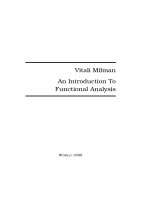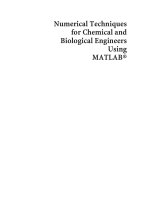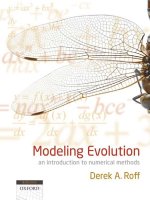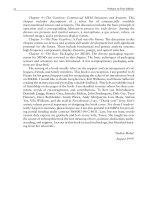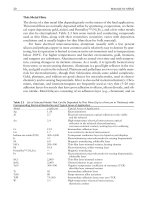an introduction to numerical analysis for electrical and computer engineers - wiley
Bạn đang xem bản rút gọn của tài liệu. Xem và tải ngay bản đầy đủ của tài liệu tại đây (8.16 MB, 605 trang )
TLFeBOOK
AN INTRODUCTION TO
NUMERICAL ANALYSIS
FOR ELECTRICAL AND
COMPUTER ENGINEERS
Christopher J. Zarowski
University of Alberta, Canada
A JOHN WILEY & SONS, INC. PUBLICATION
TLFeBOOK
TLFeBOOK
AN INTRODUCTION TO
NUMERICAL ANALYSIS
FOR ELECTRICAL AND
COMPUTER ENGINEERS
TLFeBOOK
TLFeBOOK
AN INTRODUCTION TO
NUMERICAL ANALYSIS
FOR ELECTRICAL AND
COMPUTER ENGINEERS
Christopher J. Zarowski
University of Alberta, Canada
A JOHN WILEY & SONS, INC. PUBLICATION
TLFeBOOK
Copyright
c
2004 by John Wiley & Sons, Inc. All rights reserved.
Published by John Wiley & Sons, Inc., Hoboken, New Jersey.
Published simultaneously in Canada.
No part of this publication may be reproduced, stored in a retrieval system, or transmitted in any form
or by any means, electronic, mechanical, photocopying, recording, scanning, or otherwise, except as
permitted under Section 107 or 108 of the 1976 United States Copyright Act, without either the prior
written permission of the Publisher, or authorization through payment of the appropriate per-copy fee
to the Copyright Clearance Center, Inc., 222 Rosewood Drive, Danvers, MA 01923, 978-750-8400,
fax 978-646-8600, or on the Web at www.copyright.com. Requests to the Publisher for permission
should be addressed to the Permissions Department, John Wiley & Sons, Inc., 111 River Street,
Hoboken, NJ 07030, (201) 748-6011, fax (201) 748-6008.
Limit of Liability/Disclaimer of Warranty: While the publisher and author have used their best efforts
in preparing this book, they make no representations or warranties with respect to the accuracy or
completeness of the contents of this book and specifically disclaim any implied warranties of
merchantability or fitness for a particular purpose. No warranty may be created or extended by sales
representatives or written sales materials. The advice and strategies contained herein may not be
suitable for your situation. You should consult with a professional where appropriate. Neither the
publisher nor author shall be liable for any loss of profit or any other commercial damages, including
but not limited to special, incidental, consequential, or other damages.
For general information on our other products and services, please contact our Customer Care
Department within the United States at 877-762-2974, outside the United States at 317-572-3993 or
fax 317-572-4002.
Wiley also publishes its books in a variety of electronic formats. Some content that appears in print,
however, may not be available in electronic format.
Library of Congress Cataloging-in-Publication Data:
Zarowski, Christopher J.
An introduction to numerical analysis for electrical and computer engineers / Christopher
J. Zarowski.
p. cm.
Includes bibliographical references and index.
ISBN 0-471-46737-5 (coth)
1. Electric engineering—Mathematics. 2. Computer science—Mathematics. 3. Numerical
analysis I. Title.
TK153.Z37 2004
621.3
′
01
′
518—dc22
2003063761
Printed in the United States of America.
10987654321
TLFeBOOK
In memory of my mother
Lilian
and of my father
Walter
TLFeBOOK
TLFeBOOK
CONTENTS
Preface xiii
1 Functional Analysis Ideas 1
1.1 Introduction 1
1.2 Some Sets 2
1.3 Some Special Mappings: Metrics, Norms, and Inner Products 4
1.3.1 Metrics and Metric Spaces 6
1.3.2 Norms and Normed Spaces 8
1.3.3 Inner Products and Inner Product Spaces 14
1.4 The Discrete Fourier Series (DFS) 25
Appendix 1.A Complex Arithmetic 28
Appendix 1.B Elementary Logic 31
References 32
Problems 33
2 Number Representations 38
2.1 Introduction 38
2.2 Fixed-Point Representations 38
2.3 Floating-Point Representations 42
2.4 Rounding Effects in Dot Product Computation 48
2.5 Machine Epsilon 53
Appendix 2.A Review of Binary Number Codes 54
References 59
Problems 59
3 Sequences and Series 63
3.1 Introduction 63
3.2 Cauchy Sequences and Complete Spaces 63
3.3 Pointwise Convergence and Uniform Convergence 70
3.4 Fourier Series 73
3.5 Taylor Series 78
vii
TLFeBOOK
viii CONTENTS
3.6 Asymptotic Series 97
3.7 More on the Dirichlet Kernel 103
3.8 Final Remarks 107
Appendix 3.A COordinate Rotation DI gital C omputing
(CORDIC) 107
3.A.1 Introduction 107
3.A.2 The Concept of a Discrete Basis 108
3.A.3 Rotating Vectors in the Plane 112
3.A.4 Computing Arctangents 114
3.A.5 Final Remarks 115
Appendix 3.B Mathematical Induction 116
Appendix 3.C Catastrophic Cancellation 117
References 119
Problems 120
4 Linear Systems of Equations 127
4.1 Introduction 127
4.2 Least-Squares Approximation and Linear Systems 127
4.3 Least-Squares Approximation and Ill-Conditioned Linear
Systems 132
4.4 Condition Numbers 135
4.5 LU Decomposition 148
4.6 Least-Squares Problems and QR Decomposition 161
4.7 Iterative Methods for Linear Systems 176
4.8 Final Remarks 186
Appendix 4.A Hilbert Matrix Inverses 186
Appendix 4.B SVD and Least Squares 191
References 193
Problems 194
5 Orthogonal Polynomials 207
5.1 Introduction 207
5.2 General Properties of Orthogonal Polynomials 207
5.3 Chebyshev Polynomials 218
5.4 Hermite Polynomials 225
5.5 Legendre Polynomials 229
5.6 An Example of Orthogonal Polynomial Least-Squares
Approximation 235
5.7 Uniform Approximation 238
TLFeBOOK
CONTENTS ix
References 241
Problems 241
6 Interpolation 251
6.1 Introduction 251
6.2 Lagrange Interpolation 252
6.3 Newton Interpolation 257
6.4 Hermite Interpolation 266
6.5 Spline Interpolation 269
References 284
Problems 285
7 Nonlinear Systems of Equations 290
7.1 Introduction 290
7.2 Bisection Method 292
7.3 Fixed-Point Method 296
7.4 Newton–Raphson Method 305
7.4.1 The Method 305
7.4.2 Rate of Convergence Analysis 309
7.4.3 Breakdown Phenomena 311
7.5 Systems of Nonlinear Equations 312
7.5.1 Fixed-Point Method 312
7.5.2 Newton–Raphson Method 318
7.6 Chaotic Phenomena and a Cryptography Application 323
References 332
Problems 333
8 Unconstrained Optimization 341
8.1 Introduction 341
8.2 Problem Statement and Preliminaries 341
8.3 Line Searches 345
8.4 Newton’s Method 353
8.5 Equality Constraints and Lagrange Multipliers 357
Appendix 8.A MATLAB Code for Golden Section Search 362
References 364
Problems 364
9 Numerical Integration and Differentiation 369
9.1 Introduction 369
TLFeBOOK
x CONTENTS
9.2 Trapezoidal Rule 371
9.3 Simpson’s Rule 378
9.4 Gaussian Quadrature 385
9.5 Romberg Integration 393
9.6 Numerical Differentiation 401
References 406
Problems 406
10 Numerical Solution of Ordinary Differential Equations 415
10.1 Introduction 415
10.2 First-Order ODEs 421
10.3 Systems of First-Order ODEs 442
10.4 Multistep Methods for ODEs 455
10.4.1 Adams–Bashforth Methods 459
10.4.2 Adams–Moulton Methods 461
10.4.3 Comments on the Adams Families 462
10.5 Variable-Step-Size (Adaptive) Methods for ODEs 464
10.6 Stiff Systems 467
10.7 Final Remarks 469
Appendix 10.A MATLAB Code for Example 10.8 469
Appendix 10.B MATLAB Code for Example 10.13 470
References 472
Problems 473
11 Numerical Methods for Eigenproblems 480
11.1 Introduction 480
11.2 Review of Eigenvalues and Eigenvectors 480
11.3 The Matrix Exponential 488
11.4 The Power Methods 498
11.5 QR Iterations 508
References 518
Problems 519
12 Numerical Solution of Partial Differential Equations 525
12.1 Introduction 525
12.2 A Brief Overview of Partial Differential Equations 525
12.3 Applications of Hyperbolic PDEs 528
12.3.1 The Vibrating String 528
12.3.2 Plane Electromagnetic Waves 534
TLFeBOOK
CONTENTS xi
12.4 The Finite-Difference (FD) Method 545
12.5 The Finite-Difference Time-Domain (FDTD) Method 550
Appendix 12.A MATLAB Code for Example 12.5 557
References 560
Problems 561
13 An Introduction to MATLAB 565
13.1 Introduction 565
13.2 Startup 565
13.3 Some Basic Operators, Operations, and Functions 566
13.4 Working with Polynomials 571
13.5 Loops 572
13.6 Plotting and M-Files 573
References 577
Index 579
TLFeBOOK
TLFeBOOK
PREFACE
The subject of numerical analysis has a long history. In fact, it predates by cen-
turies the existence of the modern computer. Of course, the advent of the modern
computer in the middle of the twentieth century gave greatly added impetus to the
subject, and so it now plays a central role in a large part of engineering analysis,
simulation, and design. This is so true that no engineer can be deemed competent
without some knowledge and understanding of the subject. Because of the back-
ground of the author, this book tends to emphasize issues of particular interest to
electrical and computer engineers, but the subject (and the present book) is certainly
relevant to engineers from all other branches of engineering.
Given the importance level of the subject, a great number of books have already
been written about it, and are now being written. These books span a colossal
range of approaches, levels of technical difficulty, degree of specialization, breadth
versus depth, and so on. So, why should this book be added to the already huge,
and growing list of available books?
To begin, the present book is intended to be a part of the students’ first exposure
to numerical analysis. As such, it is intended for use mainly in the second year
of a typical 4-year undergraduate engineering program. However, the book may
find use in later years of such a program. Generally, the present book arises out of
the author’s objections to educational practice regarding numerical analysis. To be
more specific
1. Some books adopt a “grocery list” or “recipes” approach (i.e., “methods” at
the expense of “analysis”) wherein several methods are presented, but with
little serious discussion of issues such as how they are obtained and their
relative advantages and disadvantages. In this genre often little consideration
is given to error analysis, convergence properties, or stability issues. When
these issues are considered, it is sometimes in a manner that is too superficial
for contemporary and future needs.
2. Some books fail to build on what the student is supposed to have learned
prior to taking a numerical analysis course. For example, it is common for
engineering students to take a first-year course in matrix/linear algebra. Yet,
a number of books miss the opportunity to build on this material in a manner
that would provide a good bridge from first year to more sophisticated uses
of matrix/linear algebra in later years (e.g., such as would be found in digital
signal processing or state variable control systems courses).
xiii
TLFeBOOK
xiv PREFACE
3. Some books miss the opportunity to introduce students to the now quite vital
area of functional analysis ideas as applied to engineering problem solving.
Modern numerical analysis relies heavily on concepts such as function spaces,
orthogonality, norms, metrics, and inner products. Yet these concepts are
often considered in a very ad hoc way, if indeed they are considered at all.
4. Some books tie the subject matter of numerical analysis far too closely to
particular software tools and/or programming languages. But the highly tran-
sient nature of software tools and programming languages often blinds the
user to the timeless nature of the underlying principles of analysis. Further-
more, it is an erroneous belief that one can successfully employ numerical
methods solely through the use of “canned” software without any knowledge
or understanding of the technical details of the contents of the can. While
this does not imply the need to understand a software tool or program down
to the last line of code, it does rule out the “black box” methodology.
5. Some books avoid detailed analysis and derivations in the misguided belief
that this will make the subject more accessible to the student. But this denies
the student the opportunity to learn an important mode of thinking that is a
huge aid to practical problem solving. Furthermore, by cutting the student
off from the language associated with analysis the student is prevented from
learning those skills needed to read modern engineering literature, and to
extract from this literature those things that are useful for solving the problem
at hand.
The prospective user of the present book will likely notice that it contains material
that, in the past, was associated mainly with more advanced courses. However, the
history of numerical computing since the early 1980s or so has made its inclusion
in an introductory course unavoidable. There is nothing remarkable about this. For
example, the material of typical undergraduate signals and systems courses was,
not so long ago, considered to be suitable only for graduate-level courses. Indeed,
most (if not all) of the contents of any undergraduate program consists of material
that was once considered far too advanced for undergraduates, provided one goes
back far enough in time.
Therefore, with respect to the observations mentioned above, the following is a
summary of some of the features of the present book:
1. An axiomatic approach to function spaces is adopted within the first chapter.
So the book immediately exposes the student to function space ideas, espe-
cially with respect to metrics, norms, inner products, and the concept of
orthogonality in a general setting. All of this is illustrated by several examples,
and the basic ideas from the first chapter are reinforced by routine use
throughout the remaining chapters.
2. The present book is not closely tied to any particular software tool or pro-
gramming language, although a few MATLAB-oriented examples are pre-
sented. These may be understood without any understanding of MATLAB
TLFeBOOK
PREFACE xv
(derived from the term matrix laboratory) on the part of the student, how-
ever. Additionally, a quick introduction to MATLAB is provided in Chapter
13. These examples are simply intended to illustrate that modern software
tools implement many of the theories presented in the book, and that the
numerical characteristics of algorithms implemented with such tools are not
materially different from algorithm implementations using older software
technologies (e.g., catastrophic convergence, and ill conditioning, continue
to be major implementation issues). Algorithms are often presented in a
Pascal-like pseudocode that is sufficiently transparent and general to allow
the user to implement the algorithm in the language of their choice.
3. Detailed proofs and/or derivations are often provided for many key results.
However, not all theorems or algorithms are proved or derived in detail
on those occasions where to do so would consume too much space, or not
provide much insight. Of course, the reader may dispute the present author’s
choices in this matter. But when a proof or derivation is omitted, a reference
is often cited where the details may be found.
4. Some modern applications examples are provided to illustrate the conse-
quences of various mathematical ideas. For example, chaotic cryptography,
the CORDIC (coordinate rotational digital computing) method, and least
squares for system identification (in a biomedical application) are considered.
5. The sense in which series and iterative processes converge is given fairly
detailed treatment in this book as an understanding of these matters is now
so crucial in making good choices about which algorithm to use in an appli-
cation. Thus, for example, the difference between pointwise and uniform
convergence is considered. Kernel functions are introduced because of their
importance in error analysis for approximations based on orthogonal series.
Convergence rate analysis is also presented in the context of root-finding
algorithms.
6. Matrix analysis is considered in sufficient depth and breadth to provide an
adequate introduction to those aspects of the subject particularly relevant to
modern areas in which it is applied. This would include (but not be limited
to) numerical methods for electromagnetics, stability of dynamic systems,
state variable control systems, digital signal processing, and digital commu-
nications.
7. The most important general properties of orthogonal polynomials are pre-
sented. The special cases of Chebyshev, Legendre, and Hermite polynomials
are considered in detail (i.e., detailed derivations of many basic properties
are given).
8. In treating the subject of the numerical solution of ordinary differential
equations, a few books fail to give adequate examples based on nonlin-
ear dynamic systems. But many examples in the present book are based on
nonlinear problems (e.g., the Duffing equation). Furthermore, matrix methods
are introduced in the stability analysis of both explicit and implicit methods
for nth-order systems. This is illustrated with second-order examples.
TLFeBOOK
xvi PREFACE
Analysis is often embedded in the main body of the text rather than being rele-
gated to appendixes, or to formalized statements of proof immediately following a
theorem statement. This is done to discourage attempts by the reader to “skip over
the math.” After all, skipping over the math defeats the purpose of the book.
Notwithstanding the remarks above, the present book lacks the rigor of a math-
ematically formal treatment of numerical analysis. For example, Lebesgue measure
theory is entirely avoided (although it is mentioned in passing). With respect to
functional analysis, previous authors (e.g., E. Kreyszig, Introductory Functional
Analysis with Applications) have demonstrated that it is very possible to do this
while maintaining adequate rigor for engineering purposes, and this approach is
followed here.
It is largely left to the judgment of the course instructor about what particular
portions of the book to cover in a course. Certainly there is more material here
than can be covered in a single term (or semester). However, it is recommended
that the first four chapters be covered largely in their entirety (perhaps excepting
Sections 1.4, 3.6, 3.7, and the part of Section 4.6 regarding SVD). The material of
these chapters is simply too fundamental to be omitted, and is often drawn on in
later chapters.
Finally, some will say that topics such as function spaces, norms and inner
products, and uniform versus pointwise convergence, are too abstract for engineers.
Such individuals would do well to ask themselves in what way these ideas are
more abstract than Boolean algebra, convolution integrals, and Fourier or Laplace
transforms, all of which are standard fare in present-day electrical and computer
engineering curricula.
Engineering past Engineering present Engineering future
Christopher Zarowski
TLFeBOOK
1 Functional Analysis Ideas
1.1 INTRODUCTION
Many engineering analysis and design problems are far too complex to be solved
without the aid of computers. However, the use of computers in problem solving
has made it increasingly necessary for users to be highly skilled in (practical)
mathematical analysis. There are a number of reasons for this. A few are as follows.
For one thing, computers represent data to finite precision. Irrational numbers
such as π or
√
2 do not have an exact representation on a digital computer (with the
possible exception of methods based on symbolic computing). Additionally, when
arithmetic is performed, errors occur as a result of rounding (e.g., the truncation of
the product of two n-bit numbers, which might be 2n bits long, back down to n
bits). Numbers have a limited dynamic range; we might get overflow or underflow
in a computation. These are examples of finite-precision arithmetic effects. Beyond
this, computational methods frequently have sources of error independent of these.
For example, an infinite series must be truncated if it is to be evaluated on a com-
puter. The truncation error is something “additional” to errors from finite-precision
arithmetic effects. In all cases, the sources (and sizes) of error in a computation
must be known and understood in order to make sensible claims about the accuracy
of a computer-generated solution to a problem.
Many methods are “iterative.” Accuracy of the result depends on how many
iterations are performed. It is possible that a given method might be very slow,
requiring many iterations before achieving acceptable accuracy. This could involve
much computer runtime. The obvious solution of using a faster computer is usually
unacceptable. A better approach is to use mathematical analysis to understand why
a method is slow, and so to devise methods of speeding it up. Thus, an important
feature of analysis applied to computational methods is that of assessing how
much in the way of computing resources is needed by a given method. A given
computational method will make demands on computer memory, operations count
(the number of arithmetic operations, function evaluations, data transfers, etc.),
number of bits in a computer word, and so on.
A given problem almost always has many possible alternative solutions. Other
than accuracy and computer resource issues, ease of implementation is also rel-
evant. This is a human labor issue. Some methods may be easier to implement
on a given set of computing resources than others. This would have an impact
An Introduction to Numerical Analysis for Electrical and Computer Engineers,byC.J.Zarowski
ISBN 0-471-46737-5
c
2004 John Wiley & Sons, Inc.
1
TLFeBOOK
2 FUNCTIONAL ANALYSIS IDEAS
on software/hardware development time, and hence on system cost. Again, math-
ematical analysis is useful in deciding on the relative ease of implementation of
competing solution methods.
The subject of numerical computing is truly vast. Methods are required to handle
an immense range of problems, such as solution of differential equations (ordi-
nary or partial), integration, solution of equations and systems of equations (linear
or nonlinear), approximation of functions, and optimization. These problem types
appear to be radically different from each other. In some sense the differences
between them are true, but there are means to achieve some unity of approach in
understanding them.
The branch of mathematics that (perhaps) gives the greatest amount of unity
is sometimes called functional analysis. We shall employ ideas from this subject
throughout. However, our usage of these ideas is not truly rigorous; for example,
we completely avoid topology, and measure theory. Therefore, we tend to follow
simplified treatments of the subject such as Kreyszig [1], and then only those ideas
that are immediately relevant to us. The reader is assumed to be very comfortable
with elementary linear algebra, and calculus. The reader must also be comfortable
with complex number arithmetic (see Appendix 1.A now for a review if necessary).
Some knowledge of electric circuit analysis is presumed since this will provide
a source of applications examples later. (But application examples will also be
drawn from other sources.) Some knowledge of ordinary differential equations is
also assumed.
It is worth noting that an understanding of functional analysis is a tremendous
aid to understanding other subjects such as quantum physics, probability theory
and random processes, digital communications system analysis and design, digital
control systems analysis and design, digital signal processing, fuzzy systems, neural
networks, computer hardware design, and optimal design of systems. Many of the
ideas presented in this book are also intended to support these subjects.
1.2 SOME SETS
Variables in an engineering problem often take on values from sets of numbers.
In the present setting, the sets of greatest interest to us are (1) the set of integers
Z ={ −3, −2, −1, 0, 1, 2, 3 }, (2) the set of real numbers R, and (3) the set of
complex numbers C ={x +jy|j =
√
−1,x,y ∈ R}. The set of nonnegative inte-
gers is Z
+
={0, 1, 2, 3, ,} (so Z
+
⊂ Z). Similarly, the set of nonnegative real
numbers is R
+
={x ∈ R|x ≥ 0}. Other kinds of sets of numbers will be introduced
if and when they are needed.
If A and B are two sets, their Cartesian product is denoted by A × B =
{(a, b)|a ∈ A, b ∈ B}. The Cartesian product of n sets denoted A
0
,A
1
, ,A
n−1
is A
0
× A
1
×···×A
n−1
={(a
0
,a
1
, ,a
n−1
)|a
k
∈ A
k
}.
Ideas from matrix/linear algebra are of great importance. We are therefore also
interested in sets of vectors. Thus, R
n
shall denote the set of n-element vectors
with real-valued components, and similarly, C
n
shall denote the set of n-element
TLFeBOOK
SOME SETS 3
vectors with complex-valued components. By default, we assume any vector x to
be a column vector:
x =
x
0
x
1
.
.
.
x
n−2
x
n−1
.(1.1)
Naturally, row vectors are obtained by transposition. We will generally avoid using
bars over or under symbols to denote vectors. Whether a quantity is a vector will
be clear from the context of the discussion. However, bars will be used to denote
vectors when this cannot be easily avoided. The indexing of vector elements x
k
will
often begin with 0 as indicated in (1.1). Naturally, matrices are also important. Set
R
n×m
denotes the set of matrices with n rows and m columns, and the elements are
real-valued. The notation C
n×m
should now possess an obvious meaning. Matri-
ces will be denoted by uppercase symbols, again without bars. If A is an n ×m
matrix, then
A = [a
p,q
]
p =0, ,n−1,q=0, ,m−1
.(1.2)
Thus, the element in row p and column q of A is denoted a
p,q
. Indexing of rows
and columns again will typically begin at 0. The subscripts on the right bracket “]”
in (1.2) will often be omitted in the future. We may also write a
pq
instead of a
p,q
where no danger of confusion arises.
The elements of any vector may be regarded as the elements of a sequence of
finite length. However, we are also very interested in sequences of infinite length.
An infinite sequence may be denoted by x = (x
k
) = (x
0
,x
1
,x
2
, ), for which x
k
could be either real-valued or complex-valued. It is possible for sequences to be
doubly infinite, for instance, x = (x
k
) = ( ,x
−2
,x
−1
,x
0
,x
1
,x
2
, ).
Relationships between variables are expressed as mathematical functions, that is,
mappings between sets. The notation f |A → B signifies that function f associates
an element of set A with an element from set B. For example, f |R → R represents
a function defined on the real-number line, and this function is also real-valued;
that is, it maps “points” in R to “points” in R. We are familiar with the idea
of “plotting” such a function on the xy plane if y = f(x) (i.e., x, y ∈ R). It is
important to note that we may regard sequences as functions that are defined on
either the set Z (the case of doubly infinite sequences), or the set Z
+
(the case
of singly infinite sequences). To be more specific, if, for example, k ∈ Z
+
, then
this number maps to some number x
k
that is either real-valued or complex-valued.
Since vectors are associated with sequences of finite length, they, too, may be
regarded as functions, but defined on a finite subset of the integers. From (1.1) this
subset might be denoted by Z
n
={0, 1, 2, ,n− 2,n− 1}.
Sets of functions are important. This is because in engineering we are often
interested in mappings between sets of functions. For example, in electric circuits
voltage and current waveforms (i.e., functions of time) are input to a circuit via volt-
age and current sources. Voltage drops across circuit elements, or currents through
TLFeBOOK
4 FUNCTIONAL ANALYSIS IDEAS
circuit elements are output functions of time. Thus, any circuit maps functions from
an input set to functions from some output set. Digital signal processing systems
do the same thing, except that here the functions are sequences. For example, a
simple digital signal processing system might accept as input the sequence (x
n
),
and produce as output the sequence (y
n
) according to
y
n
=
x
n
+ x
n+1
2
(1.3)
for which n ∈ Z
+
.
Some specific examples of sets of functions are as follows, and more will be
seen later. The set of real-valued functions defined on the interval [a, b] ⊂ R that
are n times continuously differentiable may be denoted by C
n
[a, b]. This means
that all derivatives up to and including order n exist and are continuous. If n = 0
we often just write C[a, b], which is the set of continuous functions on the interval
[a, b]. We remark that the notation [a, b] implies inclusion of the endpoints of the
interval. Thus, (a, b) implies that the endpoints a and b are not to be included [i.e.,
if x ∈ (a, b ), then a<x<b].
A polynomial in the indeterminate x of degree n is
p
n
(x) =
n
k=0
p
n,k
x
k
.(1.4)
Unless otherwise stated, we will always assume p
n,k
∈ R. The indeterminate x
is often considered to be either a real number or a complex number. But in
some circumstances the indeterminate x is merely regarded as a “placeholder,”
which means that x is not supposed to take on a value. In a situation like this
the polynomial coefficients may also be regarded as elements of a vector (e.g.,
p
n
= [p
n,0
p
n,1
··· p
n,n
]
T
). This happens in digital signal processing when we
wish to convolve
1
sequences of finite length, because the multiplication of polyno-
mials is mathematically equivalent to the operation of sequence convolution. We
will denote the set of all polynomials of degree n as P
n
.Ifx is to be from the
interval [a, b] ⊂ R, then the set of polynomials of degree n on [a, b] is denoted
by P
n
[a, b]. If m<nwe shall usually assume P
m
[a, b] ⊂ P
n
[a, b].
1.3 SOME SPECIAL MAPPINGS: METRICS, NORMS,
AND INNER PRODUCTS
Sets of objects (vectors, sequences, polynomials, functions, etc.) often have cer-
tain special mappings defined on them that turn these sets into what are commonly
called function spaces. Loosely speaking, functional analysis is about the properties
1
These days it seems that the operation of convolution is first given serious study in introductory signals
and systems courses. The operation of convolution is fundamental to all forms of signal processing,
either analog or digital.
TLFeBOOK
SOME SPECIAL MAPPINGS: METRICS, NORMS, AND INNER PRODUCTS 5
of function spaces. Generally speaking, numerical computation problems are best
handled by treating them in association with suitable mappings on well-chosen
function spaces. For our purposes, the three most important special types of map-
pings are (1) metrics, (2) norms, and (3) inner products. You are likely to be already
familiar with special cases of these really very general ideas.
The vector dot product is an example of an inner product on a vector space, while
the Euclidean norm (i.e., the square root of the sum of the squares of the elements in
a real-valued vector) is a norm on a vector space. The Euclidean distance between
two vectors (given by the Euclidean norm of the difference between the two vectors)
is a metric on a vector space. Again, loosely speaking, metrics give meaning to the
concept of “distance” between points in a function space, norms give a meaning
to the concept of the “size” of a vector, and inner products give meaning to the
concept of “direction” in a vector space.
2
In Section 1.1 we expressed interest in the sizes of errors, and so naturally the
concept of a norm will be of interest. Later we shall see that inner products will
prove to be useful in devising means of overcoming problems due to certain sources
of error in a computation. In this section we shall consider various examples of
function spaces, some of which we will work with later on in the analysis of
certain computational problems. We shall see that there are many different kinds
of metric, norm, and inner product. Each kind has its own particular advantages
and disadvantages as will be discovered as we progress through the book.
Sometimes a quantity cannot be computed exactly. In this case we may try to
estimate bounds on the size of the quantity. For example, finding the exact error
in the truncation of a series may be impossible, but putting a bound on the error
might be relatively easy. In this respect the concepts of supremum and infimum
can be important. These are defined as follows.
Suppose we have E ⊂ R. We say that E is bounded above if E has an upper
bound, that is, if there exists a B ∈ R such that x ≤ B for all x ∈ E.IfE =∅
(empty set; set containing no elements) there is a supremum of E [also called a
least upper bound (lub)], denoted
sup E.
For example, suppose E = [0, 1), then any B ≥ 1 is an upper bound for E, but
sup E = 1. More generally, sup E ≤ B for every upper bound B of E. Thus, the
supremum is a “tight” upper bound. Similarly, E may be bounded below.IfE has
a lower bound there is a b ∈ R such that x ≥ b for all x ∈ E.IfE =∅, then there
exists an infimum [also called a greatest lower bound (glb)], denoted by
inf E.
For example, suppose now E = (0, 1]; then any b ≤ 0 is a lower bound for E,
but inf E = 0. More generally, inf E ≥ b for every lower bound b of E. Thus, the
infimum is a “tight” lower bound.
2
The idea of “direction” is (often) considered with respect to the concept of an orthogonal basis in a
vector space. To define “orthogonality” requires the concept of an inner product. We shall consider this
in various ways later on.
TLFeBOOK
6 FUNCTIONAL ANALYSIS IDEAS
1.3.1 Metrics and Metric Spaces
In mathematics an axiomatic approach is often taken in the development of analysis
methods. This means that we define a set of objects, a set of operations to be
performed on the set of objects, and rules obeyed by the operations. This is typically
how mathematical systems are constructed. The reader (hopefully) has already seen
this approach in the application of Boolean algebra to the analysis and design of
digital electronic systems (i.e., digital logic). We adopt the same approach here.
We will begin with the following definition.
Definition 1.1: Metric Space, Metric A metric space is a set X and a
function d|X ×X → R
+
, which is called a metric or distance function on X.
If x, y, z ∈ X then d satisfies the following axioms:
(M1) d(x, y) = 0 if and only if (iff) x = y.
(M2) d(x, y) = d(y,x) (symmetry property).
(M3) d(x, y) ≤ d(x,z) +d(z, y) (triangle inequality).
We emphasize that X by itself cannot be a metric space until we define d. Thus,
the metric space is often denoted by the pair (X, d). The phrase “if and only
if” probably needs some explanation. In (M1), if you were told that d(x, y) = 0,
then you must immediately conclude that x = y. Conversely, if you were told that
x = y, then you must immediately conclude that d(x,y) = 0. Instead of the words
“if and only if” it is also common to write
d(x, y) = 0 ⇔ x = y.
The phrase “if and only if” is associated with elementary logic. This subject is
reviewed in Appendix 1.B. It is recommended that the reader study that appendix
before continuing with later chapters.
Some examples of metric spaces now follow.
Example 1.1 Set X = R, with
d(x, y) =|x − y| (1.5)
forms a metric space. The metric (1.5) is what is commonly meant by the “distance
between two points on the real number line.” The metric (1.5) is quite useful in
discussing the sizes of errors due to rounding in digital computation. This is because
there is a norm on R that gives rise to the metric in (1.5) (see Section 1.3.2).
Example 1.2 The set of vectors R
n
with
d(x, y) =
n−1
k=0
[x
k
− y
k
]
2
1/2
(1.6a)
TLFeBOOK


